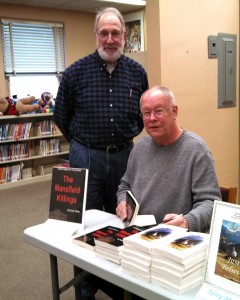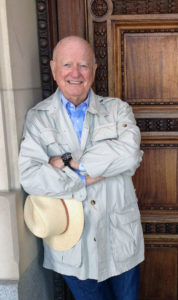

“You might ask what is my association with the place, and I will tell you that there were two men who killed six people in a two week period back in 1948 and they met each other while serving sentences there. Their names were Robert Daniels and John West, and that two week rampage is the subject of my book, The Mansfield Killings.”
And if you happen to be in the Mansfield area on Aug. 30-31, meander over to OSR to meet Scott during a book signing and maybe, just maybe, you may see a ghost.
The Ohio State Reformatory (OSR) has been a landmark in this part of Ohio for over a century.
Located about an hour’s drive north of Columbus, the reformatory boasts two features that make it famous throughout the United States. The first claim to fame is the number of movies shot within its walls which include The Shawshank Redemption and Air Force One among others. The second feature of the Ohio State Reformatory that has made it famous is that it is quite simply haunted.
OSR is considered by many to be in the top ten of the most haunted places in America. Not only has the Travel Channel’s Ghost Adventures visited the reformatory; it has been explored twice by Syfy channel’s Ghost Hunters show. It has also been featured on Fox Family Channel’s Real Scary Stories, Scariest Places on Earth, and Most Terrifying Places in America.
The prison opened its doors in 1896 to its first 150 young offenders. The doors to the prison closed in 1990 after housing over 155,000 men. Since then it has remained intact by the help of donations and volunteers by the hundreds. Guided tours are conducted throughout the summer months but come to an end in September due to the fact there is no heat in the building.
I have conducted many book signings in my life. Some were good and some not so good, but I never experienced anything like the signings that I have done at the OSR.
I had heard about the eerie things that people had experienced. I believed some but dismissed most of the stories. But that all changed when I sat there and listened to actual witnesses to such events. Even my own daughter had two experiences and she has only visited it a few times.
I think the most astounding story that I have ever heard was told to me by an older man while I was conducting a signing. He pulled out a photograph that he had taken of his brother standing in the aisle next to the empty prison cells. Standing directly behind him was the image of a much bigger man. The man, or ghost or whatever you want to call him, was posing for the picture and standing so close it looked as if he was touching the man. You can clearly see him.
Once a month, about a hundred people are allowed to spend a night in the place. They can come and go as they please looking for ghosts. A friend of mine said that he and his wife decided to spend the night sitting quietly at a table and wait for something to happen. Suddenly a figure poked its head around the corner of a window. They spoke to it and it pulled its head back. It soon reappeared then disappeared. This went on for quite some time until my friend had had enough. He walked over to the window and stuck his head outside to find no ledge, no floor, nothing to stand on.
I was next to my daughter when she took a picture of a window from the outside of the building. It was a part of the building where nobody is allowed. When we looked at the photo, there was a figure standing in the window, and I know for a fact that it was not there when she snapped the picture. She also took a picture of a cell and caught a large pink circle on the wall. We were both staring at that wall and did not see it. She immediately snapped another picture to find nothing there.
I could go on and on, but I think you get the idea. Even the Ghost Hunters from the SciFi network have been there several times.
Do you believe in ghosts? I do.
Paperback: 280 pages
Publisher: Outer Banks Publishing Group (October 24, 2012)
Language: English
ISBN-10: 0982993137
ISBN-13: 978-0982993132
Product Dimensions: 0.6 x 5.4 x 8.4 inches
Available from Amazon, Barnes and Noble and fine bookstores everywhere. And now the ebook is $.99
Outer Banks Publishing Group Author Scott Fields shared this recent newspaper article with us on the release of his newest book, The Geezer Bench.
Reprinted with permission from John Jarvis and The Marion Star
By John Jarvis
The Marion Star, Marion, Ohio
Scott Fields had written more than a half dozen books when a friend sat with him at his house to share his idea for another.
“I even have a title, ‘The Geezer Bench,’” Fields said, recalling the conversation. “Well, with just the title he got my attention.”
The novel tells the story of four friends who share their thoughts of the day as they sit on a public bench before returning to and from their private lives of mixed sorrow and happiness.
According to Fields, the book has been getting attention, “doing real well,” which pleases him for himself and for his hometown of LaRue, where he set the story in his eighth book.
“It’s not quite the same as it was back in the ’50s,” Fields, now a Mansfield resident, said. “In the ’50s it was your Norman Rockwell kind of setting: three or four grocery stores, five gas stations. You didn’t have to worry about taking your keys out of your car. … I’d go down to the Scioto River and go fishing and swimming.”
His previous book, “The Mansfield Killings,” based on a murder spree in 1948 in the Richland County city, has been his best-seller, he said. It also represented a departure from the type of writing he prefers: “I like for people to have a good feeling when they get done reading a book of mine, to see there’s a bright side at the end. That’s what life really is. That’s what I try to put in my books.”
Ironically, he’s writing another book about Robert Dale Henderson, a serial killer who claimed victims in southern Ohio, Mississippi, Louisiana, South Carolina and Florida. He learned of the murders at a book-signing for “The Mansfield Killings” in Delaware, where he met a woman who said her aunt had been married to Henderson.
“I’ve got to write something I can’t imagine,” he said, referring to the violence at the center of the story.
Retired from retail management of Kmart and Pep Boys stores, the 65-year-old Fields in his youth was a talented pitcher for Elgin High School, having been drafted 34th in the 1966 Major League Baseball Amateur Baseball Draft by the Detroit Tigers, after future Hall of Famer Reggie Jackson and before stars such as Steve Garvey and Bernie Williams. He chose instead to go to Ohio University “to learn about writing.”

Scott Fields, sitting, at one of his recent book signings.
“My grandson still does not forgive me for that,” he said. “I played baseball. My dad worked with me all those years. (But) I really didn’t like baseball. I loved to pitch. … It’s something I’ve got to live with the rest of my life. You’re 18. You don’t know much about the world. I decided I’d go to college to learn about writing.”
He said the college instruction helped, but decided a person either has the skill to write or doesn’t. “You just need to practice,” he said.
Professional writing for Fields began about 20 years ago with short stories. “I got a few published, and someone said, ‘Why don’t you write a novel?’ So I did.”
He then started looking for an agent to help him market his books. The process took about 10 years, he said, remarking, “It’s harder to get an agent than to get a book published.”
The effort has been worth it, he said, sharing that with his agent’s help he likely will have two more books published this year.
He’s been around writing his entire life.
“My mother was a writer,” he said. “She never got published, but she was a very talented writer. From the time I can remember, probably since I was 5 years old, I had the idea of a story I always wanted to write. The pressure of family and making a living kind of put it on the back (burner).”
He said in his retirement he always has three of four ideas for books he wants to write. His son, Michael Scott Fields, also recently had a book, “Spirits of the Darkness,” published.
He said he “absolutely loved writing” his latest novel, adding that typically he doesn’t read a book after he writes it, but did read The Geezer Bench and found tears running down his face. “And I wrote it. It has some real touching things in it.”
LaRue has been the setting for some of his other books, as well, but not always without constructive criticism from local residents. He said none of “The Geezer Bench” arises from his own life, adding that he won’t even claim any allusion to places and things in the story to be entirely accurate.
“Even the stuff I put in as fact like the bench in front of the dry good store is up for debate,” he said, good-naturedly.
He said although they are not yet scheduled, he plans to do two book-signing events in Marion County.
jjarvis@marionstar.com
740-375-5154
Twitter: @jmwjarvis
Then I wondered if there were enough wool sweaters, coats and whatnot around to justify stinky mothballs. I also wondered what kinds of moths eat wool – was it all species? Are they around only in warm months? Are they in Richmond or did the state pest control authority wipe them out? What’s the real story here?
All that from just the smell of mothballs one afternoon after work.

It’s nice to say you are a green company, but doing it effectively is another story.
With digital printing we don’t have thousands of books sitting in warehouses waiting to be sold – spent resources that may or may not be purchased and read.
We print books only when an order is received.
The majority of our book sales (85%) are electronic as manufacturers of ereaders have opened their walled gardens allowing their books to be read on any device, any platform, anywhere, anytime.
Think printed books will go away? No way. Did movie theaters close when home theater systems became mainstream?
The Association of American Publishers reported that the annual growth rate for eBook sales fell during 2012, to about 34% – a sharp decline from the triple-digit growth of the preceding four years.
But that doesn’t mean ebooks are going away. A recent Pew Research Center survey showed that adults who have read an e-book increased from 16% to 23% in the past year. It also revealed that 89% of regular book readers said that they had read at least one printed book in the last year.
Ebooks are merely another channel, another technology to promote, sell and enjoy books. It compliments printed books. Printed books won’t go away – there will just be fewer printed.
Fewer printed books is not good for the big six publishers, but it won’t bankrupt them – just lower their sales volume and profit margins.
That’s why they won’t fully embrace ebooks and why they charge artificially high prices for their ebooks close to the full price of their printed books.
They want to revive the same high profit margins they enjoyed with print books for so many decades.
But they will never convince their customers or the general public that ebooks cost as much as print books to edit, process and distribute.
Ebooks are a disruptive technology and like all disruptive technologies is condemned, rejected and deemed catastrophic for society by those who stand to lose.
The market will determine the accepted price of ebooks, not the publishers and there is nothing they can do to stop it. The tsunami has already hit land.

Outer Banks Publishing Group author Mary L. Tabor’s literary novel, Who by Fire, won the Notable Indie award for best books in 2013 by online magazine Shelf Unbound.
Shelf Unbound’s second annual writing competition had over 1,000 entries with 100 titles chosen as winners, according to Shelf Unbound’s publisher, Margaret Brown.
Mary’s book was featured in the December-January 2014 special edition of Shelf Unbound magazine (Page 35).
“Thanks to the Internet, artists can be discovered by a global audience-and in some cases even be funded by philanthropic strangers. The challenge, of course, is the discovery part-how do the indie artist and the indie audience find each other? That’s what this special issue of Shelf Unbound-honoring the winner, finalists, and notable entries in our second writing competition for best indie book-is all about,” wrote Ms. Brown.
Congratulations to Mary for her notable achievement!
Book reviews with GIFs, those tiny videos that play over and over, are rather controversial among the old guard of book reviewers. Read Laura Miller’s insightful and informative piece. Start with the excerpt below.
“The GIFs and images used in the two reviews are, like the vast majority of visual elements cropping up in reviews and other critical discussions online, reaction GIFs: looped clips taken from commercially produced film and television, often featuring popular actors such as Emma Stone or Jennifer Lawrence rolling their eyes, gaping in astonishment, jumping with glee, shrugging their shoulders. They serve to underline the reviewer’s point, rather than to make it, and they can come across as exaggerated and sarcastic, even bratty. But so what? It’s not as if traditionally published professional book reviews haven’t been equally harsh at times, and in this case, the reviews are highly attuned to their intended audience with its densely networked language of cultural references. Besides, as longtime Goodreads member Ceridwen (who doesn’t use images or GIFs herself) explained to me in an email, ‘These reviews often use the very same critical tools found in professional reviews — parsing of character and tone, close reading, comparison with other works or larger cultural positioning — [but] there’s no fiction of critical distance, and the emotional reaction is as important as the aesthetic one.'” >more
FRANKFORT, KY – Kentucky’s Capital City is reeling as a new Governor’s actions play havoc with the town, a perfect murder is still unsolved; there is a suicide, a showdown, and a long-ago love rekindling—that’s what he had to deal with When Theo Came Home, the concluding novel in Ron Rhody’s Theo Trilogy.
When Theo Cam e Home was released at the Kentucky Book Fair in Frankfort on Saturday, November 16, but Outer Banks Publishing Group is offering a special pre-launch price of $12.99 .
e Home was released at the Kentucky Book Fair in Frankfort on Saturday, November 16, but Outer Banks Publishing Group is offering a special pre-launch price of $12.99 .
The Kentucky Book Fair is the state’s largest. It is co-sponsored by the Kentucky Department of Libraries & Archives, the University Press of Kentucky, and The State Journal, the capital city’s daily newspaper. Held at the Frankfort Convention Center, the Fair attracts over 150 authors and averages over 4,000 attendees. All proceeds go to support public schools and libraries throughout the Commonwealth.
The three books in the Theo Trilogy are set in the Commonwealth’s fabled Bluegrass region and the Capital City of Frankfort and cover a time span ranging from the early 1950s to the first few years of the 1980s.
Rhody grew up in the town he writes about and began his career there. He’s been a reporter, a sportswriter, a broadcast newsman, and covered the Kentucky legislature before moving on to a career as a corporate public relations executive in New York and San Francisco. Both cities figure in this story, too, and the mountains of the Southern Appalachians where snake-handling cults still thrive.
The two other books that make up the Theo Trilogy are Theo’s Story, published in 2010, and Theo & The Mouthful of Ashes, published in 2011.
Order your copy at a special pre-launch price of $12.99, list $15.99.
“The characters are richly drawn. The action runs at a riveting pace. What happened When THEO Came Home is a helluva read and a fine, fine story.” – Ian Kellogg
When THEO Came Home is the concluding novel in the THEO Trilogy. The other books in the series are: THEO’s Story and THEO & The Mouthful of Ashes, both available on Amazon in print and ebook format and in fine bookstores everywhere.
_____________________________
Outer Banks Publishing Group
ISBN-13: 978-0982993101
ISBN-10: 0982993102
BISAC: Fiction / Suspense
JCC Clip from Mary Tabor on Vimeo.
 Here’s what Richard Kramer, writer and producer of the TV show Thirtysomething, among others, and author of These Things Happen, a novel he wrote and has adapted for an HBO series produced by Oprah Winfrey wrote about Mary L. Tabor’s sensual, sensitive novel, WHO BY FIRE.
Here’s what Richard Kramer, writer and producer of the TV show Thirtysomething, among others, and author of These Things Happen, a novel he wrote and has adapted for an HBO series produced by Oprah Winfrey wrote about Mary L. Tabor’s sensual, sensitive novel, WHO BY FIRE.
“This brief, elegant, passionate novel accumulates and gathers force like a poem, in which language is compressed and edited and somehow bursts its bounds as it goes along. It made me want to write a book just like it, although I don’t have Mary Tabor’s wisdom and insight and willingness to stay so intently focused. Maybe someday … Until then, I can heartily recommend this, maybe especially to people who haven’t written a novel but who want to, because WHO BY FIRE can show you what a novel can be.”
Mary L. Tabor with Richard Kramer 08/07 by rarebirdradio | Books Podcasts.
Listen to Mixcloud’s interview with Outer Banks Publishing Group author Mary L. Tabor. She discusses her newest novel, Who by Fire, where one of the main characters who died, lives throughout the story.
The interview starts at 50:26 into the broadcast.
Mary L Tabor 03-14-13 by Total Education Network on Mixcloud
Mixcloud connects radio content to listeners more effectively. Mixcloud is re-thinking radio by joining the dots between radio shows, Podcasts and DJ mixes. We refer to them as Cloudcasts – audio shows that are stored in the “cloud” and available to be streamed on-demand.